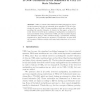Free Online Productivity Tools
i2Speak
i2Symbol
i2OCR
iTex2Img
iWeb2Print
iWeb2Shot
i2Type
iPdf2Split
iPdf2Merge
i2Bopomofo
i2Arabic
i2Style
i2Image
i2PDF
iLatex2Rtf
Sci2ools
ICFEM
2005
Springer
2005
Springer
29 New Unclarities in the Semantics of UML 2.0 State Machines
Abstract. UML 2.0, which is the standard modeling language for objectoriented systems, has only an informally given semantics. This is in particular the case for UML 2.0 state machines, which are widely used for modeling the reactive behavior of objects. In this paper, a list of 29 newly detected trouble spots consisting of ambiguities, inconsistencies, and unnecessarily strong restrictions of UML 2.0 state machines is given and illustrated using 6 state machines having a problematic meaning; suggestions for improvement are presented. In particular, we show that the concepts of history, priority, and entry/exit points have to be reconsidered.
ICFEM 2005 | State Machines | UML 2.0 | UML 2.0 State |
| Added | 27 Jun 2010 |
| Updated | 27 Jun 2010 |
| Type | Conference |
| Year | 2005 |
| Where | ICFEM |
| Authors | Harald Fecher, Jens Schönborn, Marcel Kyas, Willem P. de Roever |
Comments (0)

